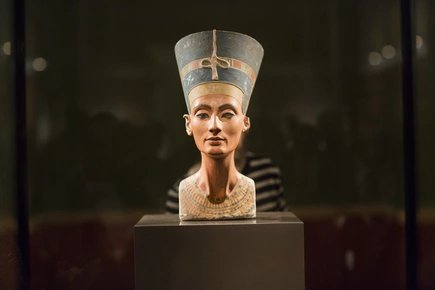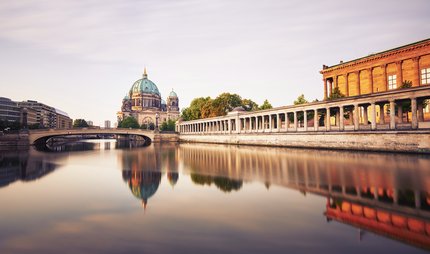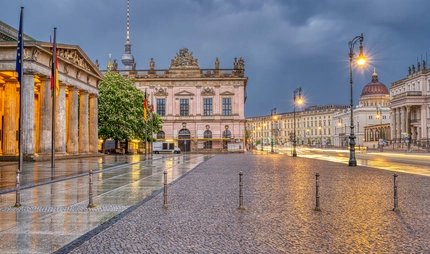
Berlin Cathedral
Cathedral Church of Berlin and burial place of the Hohenzollern
The monumental Cathedral Church in Berlin is a major attraction – a richly decorated church interior, fascinating history and impressive architecture.
The Hohenzollern crypt is not accessible until Spring 2026.
The magnificent dome of the Cathedral Church (Berliner Dom) is one of the main landmarks in Berlin’s cityscape – and marks the spot of the impressive basilica housing the city’s most important Protestant church. With its elaborate decorative and ornamental designs, the church interior is especially worth seeing.
Yet although the church is known as a cathedral, it actually has the status of a parish church – though not just any parish. This was a representative stage for the Hohenzollern dynasty, the rulers of Prussia and later the German Emperors. Today, as the High Parish and Cathedral Church, the church serves the Protestant community in Berlin and the surrounding areas. The congregation is not based on place of residence, but open through admission to all baptised Protestants in the region.
History
The history of the Berlin Cathedral goes back to the 15th century. The predecessor buildings were originally part of the Berlin City Palace.
In the early nineteenth century, Prussia’s leading architect Karl Friedrich Schinkel transformed the court church into a neo-classical building.
Larger and more magnificent
But fifty years on, tastes had changed. By the time Wilhelm II came to throne as Emperor of Germany in 1888, several designs had been proposed for a new church, though none had been accepted. The Emperor also found the Schinkel church far too modest, and insisted on a new monumental church in keeping with the imperial monarchy’s power and prestige. Architect Julius Carl Raschdorff was commissioned for the new church, but had to present three designs before Wilhelm II was satisfied. Raschdorff’s opulent, grandiose structure was for him Berlin’s answer to Saint Peter’s in Rome and Saint Paul’s Cathedral in London.

The old building was demolished in 1893, and the foundation stone for the new church laid in 1894. Eleven years later in 1905, the new church was consecrated. The church was severely damaged during the Second World War. After the division of Germany, the Cathedral Church was in East Berlin. The work on restoring the church began there in 1975, although in a simplified form.
The full restoration was only completed in 1993, four years after the Berlin Wall fell. Finally, in 2008, a new golden cross replaced the dome cross in need of renovation. Today, the old cross is located on one of the cathedral cemeteries in Liesenstraße 6.
Architecture

The Cathedral Church is dominated by a monumental dome crowned by a lantern with a golden cross and flanked by four towers. Raschdorff drew his inspiration from the Italian High Renaissance and the more florid baroque style. With its lavish mix of ornamental mosaics, gold features and impressive statues, the interior is clearly informed by the late nineteenth century’s love of grand gestures and display. The most notable works of art are the marble and onyx altar, designed by Friedrich August Stüler, and the white marble baptismal font by Christian Daniel Rauch. In the Baptismal and Matrimonial Chapel, the monumental painting of the Descent of the Holy Spirit by Carl Begas in the style of Raphael is also well worth seeing.

Visiting the Cathedral Church
The main nave with the massive dome soaring above it is certainly one of the church’s signature sights, and not to be missed. In contrast, the simpler Baptismal and Matrimonial Chapel is far more meditative, inviting visitors to stop, rest and reflect. In the Hohenzollern crypt (reopening in autumn 2025) which has been closed for reconstruction and renovation work, is the most important dynastic sepulchre in Germany. It contains nearly 100 sarcophagi and burial monuments from five centuries. Some are plain and simple, while others are extremely ornate as, for example, the sarcophagi under the galleries in the upper church room carved by Andreas Schlüter for Friedrich I and Queen Sophie Charlotte, which are ranked as masterpieces of baroque sculpture.
Emperor Frederick William II, however, did not find his last rest in his church, but in Dutch exile.

The museum showcases drawings, designs and models illustrating the history of the Cathedral Church. In particular, the walk-in models give an impressive sense of the church interior. And to get a marvellous impression of the exterior, you can climb 270 steps to the dome’s outer walkway – and be rewarded by some stunning panoramic views! The richly decorated Imperial Staircase was intended for the use of the German Emperor. The stairwell comes with an American-made elevator included at the wish of Kaiser Wilhelm II, an enthusiastic follower of new technologies. The staircase and elevator are only accessible to visitors on special occasions.
There is no viewing of the Cathedral Church during religious services and events.
You can find an overview of all religious services, vespers and worship on the Cathedral Church’s website.
Concerts in the Cathedral Church
It is quite an experience to visit a concert in this magnificent setting. The rich tones of the historic organ, one of the most famous by the renowned Sauer organ builders, can be heard during services and special concerts. Visitors can view this impressive musical instrument in detail on the dedicated organ tours. The Cathedral Church is also home to two outstanding choirs, the Domkantorei and the Staats- und Domchor Berlin, which provide choral accompaniment for the services and perform individual concerts. With its strong and vibrant musical tradition, the Cathedral Church offers a regular programme of concerts, including the highlight of the International Organ Summer an concerts in the Advent and christmas season.
Sights in the vicinity

- Unter den Linden boulevard
- Museum Island
- Humboldtforum / Berlin City Palace
- Zeughaus (Arsenal)
- Neue Wache (New Guardhouse)
For information on opening hours, guided tours and school visits, please consult the website.
Download your digital city guide for free now:
Use our App to explore Berlin on site or discover the capital virtually: ABOUT BERLIN is your personal city guide with lots of insider information!
Explore the future through history with ABOUT BERLIN
Monday - Thursday: 10 am - 6 pm
Friday - Saturday: 10 am - 5 pm
Sunday: 12 - 17 h



